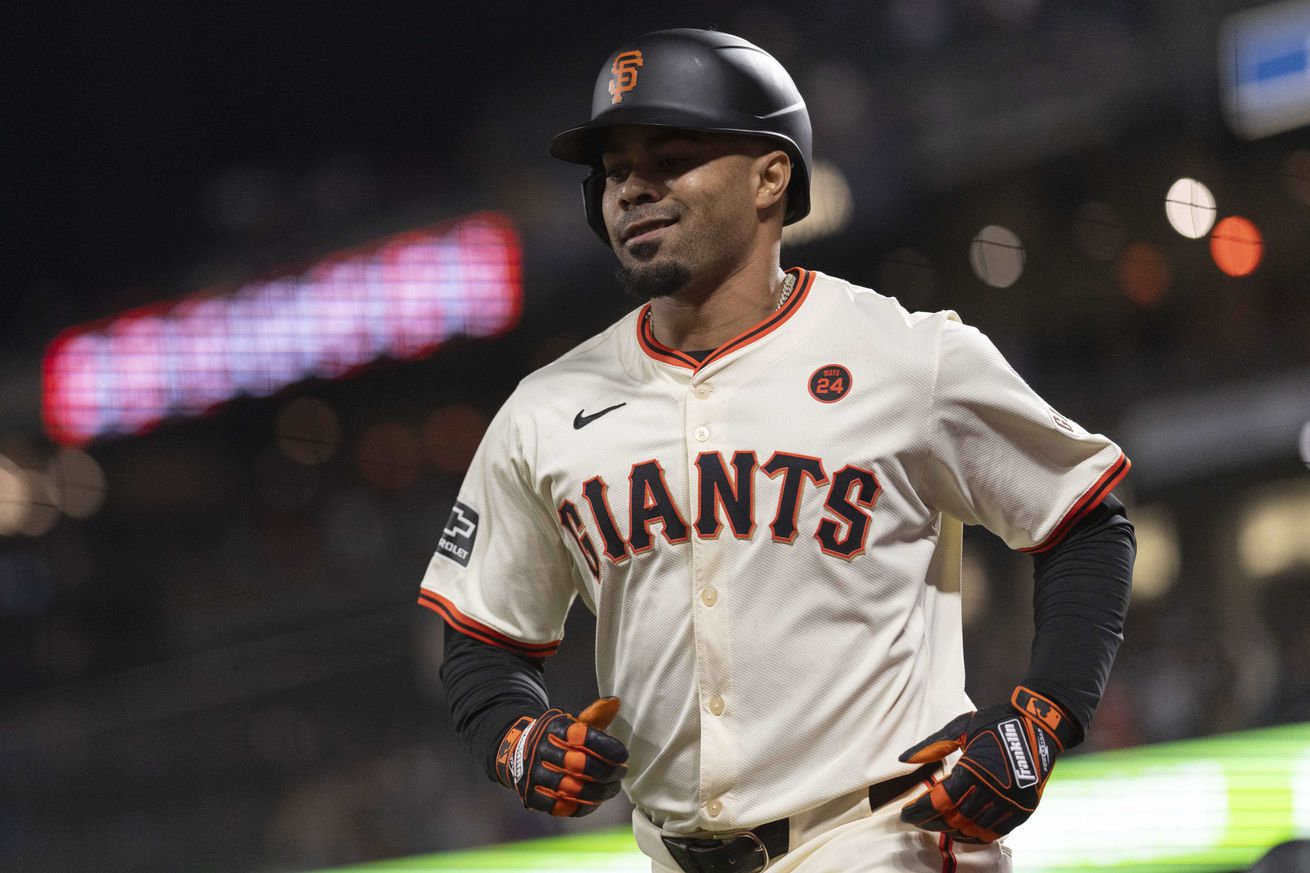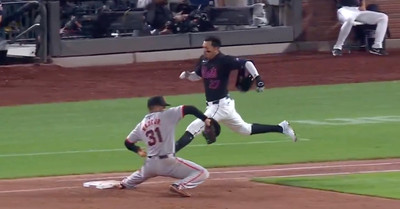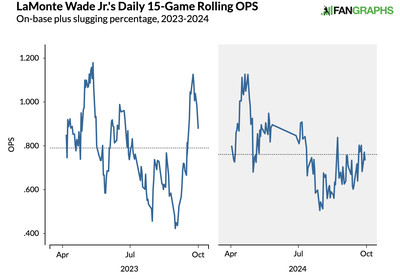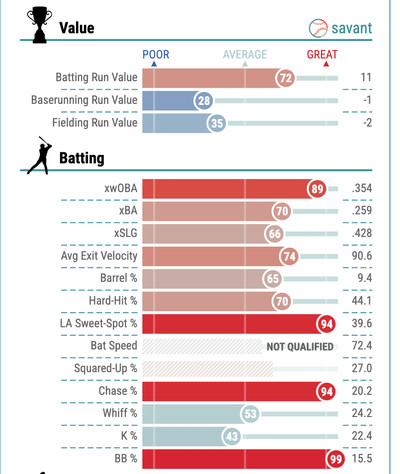
Our Juan Soto.
2024 stats: 117 G, 401 PA, .260/ .380/ .381, .761 OPS, 119 wRC+, .121 ISO, 15.5 BB%, 22.4 K%
Let’s talk about “The Pick”.
Matt Chapman’s bare-handed play ➡️ Lamonte Wade Jr.’s stretch at first base
The San Francisco Giants finished the game against the New York Mets with a walk-off defensive gem.
“That’s as good a play to end a game as you can ever have.”
@SFGiantspic.twitter.com/6QGYonKPJ2
— The Athletic (@TheAthletic) May 25, 2024
Now it’s not completely clear what “pick” Javy Lopez was referring to when he exclaimed in unfettered glee over the live game broadcast: “Pick it like a booger!”
Was it Matt Chapman’s bare-handed “pick” charging in on the infield grass to ensnare the slow roller off the bat of Mark Vientos? Or LaMonte Wade Jr.’s groin-straining “pick” at first? Now this was the second “walk-off” defensive play in consecutive days for Chapman, so vibes around our third baseman were high. Javy was almost certainly talking about Chap — but does the barehanded play even qualify as “a pick?” Yes, he did quite literally pick up the ball — an essential first step in any defensive gem — but the verb doesn’t quite capture the act. For a baseball to be picked, I feel like it needs to be moving at a higher velocity. The ball has to be low and hairy, or sharp and direct, traveling with such intent elsewhere that to be intercepted, or caught, feels unexpected. The destination meeting the object rather than the other way around.
If a true pick hinges on the element of abrupt surprise then LaMonte’s efforts might take the cake here. It would be hard to be surprised by anything Chapman achieves defensively at third. This is the expectation of greatness, heavy lies the crown. Not so for someone like LaMonte, a lowly first baseman, a position populated by thumbs, oven mitts, blind squirrels. Not to take anything away from the miraculous works performed at Chappy’s hands, but it takes two to tango, and LaMonte’s stretch / split / butt-scraping crab crawl is the dance — albeit a clumsy one — that saves the day.
Off-balanced and in a rush, the ball leaves Chapman’s hand funky. The throw over is a change-up. It barrels into the infield grass and kicks high off the grass at a prickly distance from first as Vientos barrels towards the bag as well. LaMonte is the point where two lines converge. This is the dramatic geometry of sport. The collision of two objects. The bang-bang. The stretch is more of a sprawl, a wider net. He loses his footing but somehow pulls off the awkward, chin-high backhand — not really a scoop, a kind of corral, certainly a pick.

The stakes, the group-effort makes it the defensive play of the San Francisco Giants season. People knew it the moment after Wade stuck his glove triumphantly in the air to the umpire, the baseball nestled in it. Delirium set in, silly things were said, but that was okay because people were feeling good. We needed an excuse to feel good. It’d been a hard… well decade… but more specifically, May. So LaMonte’s pick gave cause to celebrate: it preserved an 8-7 win, sealed San Francisco’s seventh victory in eight games, and finally drew them to a .500 record (26-26) for the first time since the fourth game of the season. Despite the month’s craziness — the injuries, shifting roster, rookie surges and subsequent crashes, bullpen meltdowns, late-game comebacks — the Giants buzzed with the unexpected, the surprise of it all.
This didn’t last. The Picker’s pick proved to be a last hurrah. Two days later Wade exited a game in the 5th inning against Philadelphia after an awkward slide into second. A hamstring strain would keep him off the field for a month.
Up to that point, LaMonte Wade Jr. had been the most effective bat in the line-up. He led all position players with a 1.9 fWAR while hitting .333 with a .896 OPS, a MLB-leading .470 OBP (min 160 PA), a 20% BB% and a 161 wRC+. Losing Jung Hoo Lee to injury took a chunk out of the morale, it hurt the club’s spirit; losing Wade just hurt the club period.
After his departure, the Giants dropped six of their next seven games, effectively erasing the progress made during their gilded hot-streak, and fell from 5 games back in the division to 9. Of course, the Giants were never going to make a play for the division. They were not on the launch pad with their shuttle seconds from lift-off when the rockets malfunctioned. It’d be revisionist to say that Wade’s bungled slide sank the Giants’ chances at making a push for the West…but it sure would be dramatic. And what’s January for? Football?? Heck naw! Mid-winter is for torturing ourselves with wild speculations and what-ifs just as generations of Giants fans have since Bobby Richardson picked a Willie McCovey liner out of that early autumn air in 1962.
Is it not within the realm of possibility that a few more weeks of peak Wade may have changed San Francisco’s fortunes in the late-season Wild Card push? Finding ten wins on that calendar is a tall order to pin on one player, but Wade certainly brought more things to the table than he took from it. His 1.0 Win Probability Added (0.99 on FanGraphs) isn’t Shohei’s 7-point-whatever-who-cares WPA, but as the second highest mark on the club behind Heliot Ramos’s 1.4 WPA, it’s kinda all the Giants got. At least it’s in the positive — which is more than Bryce Harper can say!
Unfortunately it wasn’t just time Wade lost thanks to his hamstring strain, he also lost his mojo. There was no consistency between Late-May LaMonte and Late-June LaMonte, and frankly both were shades wandering in the long shadow of Late-Night and his 3.2 WPA.
After his June 28 return, Wade’s offensive prediction nose dived below league average, slashing .213 / .316 / .359 with a 89 wRC+ (235 PA) through the end of the season. The fall-off mirrored a similar mid-year tumble in his 2023 campaign, one in which he spent the final months regaining not his excellence, but his footing.

Despite this, Bryan justifiably deemed the 2023 season a “career year” in his player review, and comparing this year’s final numbers, 2024 wasn’t far off this mark. Baseball Reference’s OPS+ graded him slightly better in ‘24 than in ‘23, while Fangraphs wRC+ graded him a hair better in ‘23. Potato potato. Tomato tomato. (FYI: those previously paired words should be read with different pronunciations to illustrate my point that no matter what stat database you prefer, Wade has been an offensive asset as a Giant these past two seasons).
The biggest difference between the two years has been his power numbers. His slugging percentage dropped nearly 40 points from .417 to .381, which is a hundred points lower than it was in 2021. His ISO saw a similar decline from .229 in ‘21 to .161 in ‘23 to .121 in ‘24. In fact as an on-base savant before his injury in late May, he had an even lower ISO at .093. He had hit just two homers in that time. Obviously it’d be nice if Wade could pop and walk like an Aaron Judge or Juan Soto, but for most players it’s one or the other. Work a free base a fifth of the time, or rip an extra base hit a fifth of the time?
If Wade can sustain something like a .400 OBP for any significant amount of time in 2025 (as he’s done the past two seasons), we should be happy, especially given his cost and role as a $5 million dollar first base platoon. If his on-base percentage dips for the sake of his slugging (as STEAMER projections predict) so be it. I trust the Wade plate approach: A swing that is short and fast, that gets the barrel to the ball at an above average rate, that doesn’t chase.

At this point, much like his right-handed counterpart at first, Wilmer Flores, it’s all about health, it’s about maintaining confidence in his foundational lower half. And ultimately, 2025 is about bridging the gap between now and(fingers crossed, knock-on-wood) the start of the Bryce Eldridge era.